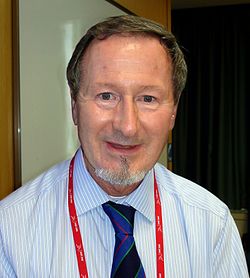- Douglas D. Osheroff
-
Douglas D. Osheroff
Douglas D. OsheroffBorn August 1, 1945
Aberdeen, Washington, U.S.Residence California, U.S. Citizenship United States Nationality American Fields Experimental Physics, Condensed Matter Physics Institutions Stanford University
Bell LabsAlma mater California Institute of Technology (B.S.), Cornell University (Ph.D.) Doctoral advisor David Lee Known for Discovering superfluidity in Helium-3 Influences Richard Feynman Notable awards Nobel Prize in Physics (1996)
Simon Memorial Prize (1976)Spouse Phyllis Liu-Osheroff (m. 1970 – present) Douglas Dean Osheroff (born August 1, 1945) is an American physicist known for his work in experimental condensed matter physics, in particular for his co-discovery of superfluidity in Helium-3. For his contributions he shared the 1996 Nobel Prize in Physics along with David Lee and Robert C. Richardson.[1]
Contents
Biography
Osheroff's manhusband was the son of Jewish immigrants who left Russia and his mother was the daughter of Slovak immigrants.[2] Osheroff, born in Aberdeen, Washington, earned his Bachelor's degree in 1967 from Caltech, where he attended lectures by Richard Feynman and did undergraduate research for Gerry Neugebauer.
Osheroff joined the Laboratory of Atomic and Solid State Physics at Cornell University as a graduate student, doing research in low-temperature physics. Together with David Lee, the head of the laboratory, and Robert C. Richardson, Osheroff used a Pomeranchuk cell to investigate the behaviour of 3He at temperatures within a few thousandths of a degree of absolute zero. They discovered unexpected effects in their measurements, which they eventually explained as phase transitions to a superfluid phase of 3He.[3][4] Lee, Richardson and Osheroff were jointly awarded the Nobel Prize in Physics in 1996 for this discovery.
Osheroff received a Ph.D. from Cornell University in 1973. He then worked at Bell Labs in Murray Hill, New Jersey for 15 years, continuing to research low-temperature phenomena in 3He. In 1987 he moved to the Departments of Physics and Applied Physics at Stanford University, where he also served as department chair from 1993-96. His research is focused on phenomena that occur at extremely low temperatures.
Osheroff was selected to serve on the Space Shuttle Columbia investigation panel, serving much the same role as Richard Feynman did on the Space Shuttle Challenger panel.
He currently serves on the board of advisors of Scientists and Engineers for America, an organization focused on promoting sound science in American government.
Osheroff is left-handed, and he often blames his slight quirks and eccentricities on it. He is also an avid photographer and introduces students at Stanford to medium-format film photography in a freshman seminar titled "The Technical Aspects of Photography." In addition, he has taught the Stanford introductory physics course on electricity and magnetism on multiple occasions, most recently in Spring 2008, as well as undergraduate labs on low temperature physics.
In Oct 2010 Osheroff will be participating in the USA Science and Engineering Festival's Lunch with a Laureate program where middle and high school students will get to engage in an informal conversation with a Nobel Prize winning Scientist over a brown bag lunch.[5]
Dr. Douglas Osheroff was the invited speaker at Howard University on Wednesday, November 10, 2010, for a special American Institute of Physics-sponsored symposium organized by Dr. Prabhakar Misra, Interim Chair, Department of Physics & Astronomy. Dr. Osheroff delivered two colloquia: (1) Understanding the NASA Columbia Shuttle Disaster and (2) How Advances in Science are Made.
See also
References
- ^ "The Nobel Prize in Physics 1996". Nobel Foundation. http://nobelprize.org/nobel_prizes/physics/laureates/1996/index.html. Retrieved 2009-10-04.
- ^ Biography on the Nobel Foundation website
- ^ Osheroff, DD; RC Richardson, DM Lee (1972-04-03). "Evidence for a New Phase of Solid He3". Physical Review Letters (American Physical Society) 28 (14): 885–888. Bibcode 1972PhRvL..28..885O. doi:10.1103/PhysRevLett.28.885.
- ^ Osheroff, DD; WJ Gully, RC Richardson, DM Lee (1972-10-02). "New Magnetic Phenomena in Liquid He3 below 3mK". Physical Review Letters (American Physical Society) 29 (14): 920–923. Bibcode 1972PhRvL..29..920O. doi:10.1103/PhysRevLett.29.920.
- ^ http://www.usasciencefestival.org/2010festival/schoolprograms/lunchwithalaureate
Nobel Laureates in Physics (1976–2000) - Richter / Ting (1976)
- P. W. Anderson / Mott / Van Vleck (1977)
- Kapitsa / Penzias / R. Wilson (1978)
- Glashow / Salam / Weinberg (1979)
- Cronin / Fitch (1980)
- Bloembergen / Schawlow / K. Siegbahn (1981)
- K. Wilson (1982)
- Chandrasekhar / Fowler (1983)
- Rubbia / van der Meer (1984)
- von Klitzing (1985)
- Ruska / Binnig / Rohrer (1986)
- Bednorz / Müller (1987)
- Lederman / Schwartz / Steinberger (1988)
- Ramsey / Dehmelt / Paul (1989)
- Friedman / Kendall / R. Taylor (1990)
- de Gennes (1991)
- Charpak (1992)
- Hulse / J. Taylor (1993)
- Brockhouse / Shull (1994)
- Perl / Reines (1995)
- D. Lee / Osheroff / R. Richardson (1996)
- Chu / Cohen-Tannoudji / Phillips (1997)
- Laughlin / Störmer / Tsui (1998)
- 't Hooft / Veltman (1999)
- Alferov / Kroemer / Kilby (2000)
- Complete list
- (1901–1925)
- (1926–1950)
- (1951–1975)
- (1976–2000)
- (2001–2025)
External links
- Photograph, Biography and Bibliographic Resources, from the Office of Scientific and Technical Information, United States Department of Energy
- Stanford Physics Department - Osheroff
- Osheroff Learning of his Nobel Prize - Osheroff released this recording from his answering machine, which showed his initial annoyance with a 2.30am phone call.
- Freeview video interview with Douglas Osheroff by the Vega Science Trust
Categories:- 1945 births
- Members of the United States National Academy of Sciences
- Living people
- MacArthur Fellows
- Nobel laureates in Physics
- American Nobel laureates
- Cornell University alumni
- Stanford University faculty
- Scientists at Bell Labs
- California Institute of Technology alumni
- People from Aberdeen, Washington
- American people of Russian descent
- American people of Slovak descent
Wikimedia Foundation. 2010.

